Champagne tours from Paris
Champagne tours from Paris take a day. Discover the Champagne sparkling wines, the most famous in the world, the Reims Gothic Cathedral and the vineyards. Visit Moët & Chandon cellars in Epernay. Paris wine tours.
Moët & Chandon tour Epernay
It is relaxing and convenient to book a guided tour one day Champagne tour. Discover the Champagne landscapes and the richness of the champagne know-how. In Epernay, enjoy a guided tour of Moët & Chandon in Epernay, one of the most famous champagne houses. Immerge yourself in the history of the house and their manufacturing process and discover the expertise of the oenologists and the heritage of a know-how. This visit ends with the tasting of their famous champagnes.

Champagne is famous worldwide for celebrations
Discover Champagne with locals
57 min by train from Paris, dine with Julien & Jorge at their manor house in Champagne. Taste Champagne, stroll through the vineyards and the village, visit a Champagne producer at his estate. Information and booking.
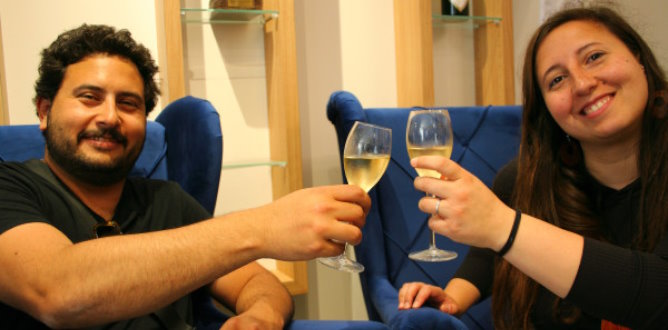
Visit Epernay in Champagne
We suggest you go to Epernay, 26 km from Reims. Epernay is a little town, so different from Paris, its activity and size. To get to Epernay from Reims, you will drive through the lovely Champagne wine country.
Locate Epernay on France map
In Epernay, visit famous Champagne wine cellars. We recommend world famous Moët & Chandon and Mercier.
Epernay 51200 France
Epernay 51200 France
Enjoy your Champagne wine country tour.
Famous places in France
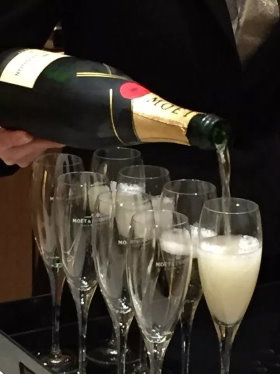
Tasting Moët & Chandon in Epernay
Visit Reims
Spend half a day in Reims, a famous place in France. Her two major sights are the Champagne cellars and Notre-Dame Cathedral, the venue of the coronation of the French Kings and a Unesco world heritage site. Don't skip Saint-Rémi, a beautiful and historical church.
The most interesting Champagne cellars to be visited in Reims are Mumm, Pommery and Ruinard, three prestigious Champagne brands.
Locate Reims on France map
Reims 51100 France
Reims 51100 France
Reims 51100 France
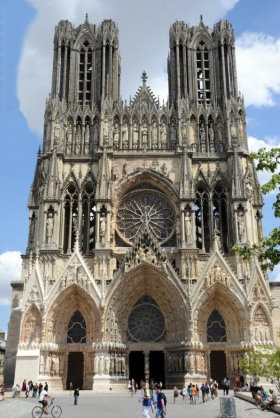
Reims Cathedral is a famous place in France
Paris to Reims by car or train
Get by car to Champagne wine country. Reims is 140 kilometers east from Paris, a 90 minute car ride on A4. On the way, you can visit some of the many moving WW1 American memorials, such as Belleau Wood (Web site).
It takes 45 minutes by high speed train (TGV) from Gare de l'Est station (Paris map) to Reims and you don't risk traffic jams. Check train schedules and buy tickets. The return trip from Paris by train takes a half day to a full day.

Take a train in Gare de l'Est to Reims
Maison Mumm in Champagne
Maison Mumm has been producing wines in Germany since 1761. It owned large vineyards in the Rhine Valley and made the wines itself. It understood the commercial potential of Champagne wine in early 19th century and created a branch in Reims. The Mumm vineyard now covers 218 hectares. Strongly dominated by Pinots Noirs (78%), especially from the Reims mountain, it also extends to the Grands Crus of Chardonnay de Cramant and Avize on the Côte des Blancs and to the Marne Valley for Pinots Meuniers. Mumm understood very early on the importance of quality, starting from the vineyard and going to pressing. Mumm also bought grapes directly from the winegrowers, making it possible to control the quality of the grapes. True partnerships were established with the winegrowers whose Mumm demands "the best there is". In 1876, Mumm decided to decorate the neck of the bottles of his raw cuvée with a red silk ribbon. Le Cordon Rouge became in a few years the symbol of the Champagne spirit.
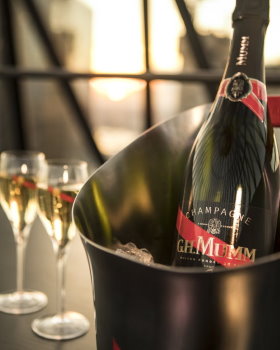
Champagne Mumm in Reims
Reims Cathedral history
Cathedral of the coronations, Notre-Dame de Reims is the former sanctuary of French royalty. A first cathedral was built in the 5th century. Already dedicated to the Blessed Virgin, this building hosted the baptism of Clovis (498) consecrated by the Archbishop Saint Rémi. In 816, Charlemagne's son, Louis le Pieux chose Reims to be crowned emperor. King Henry I (1027) definitively fixed the place of coronation in Reims. A violent fire in 1210 ravaged the Carolingian cathedral. In 1211, Archbishop Aubry de Humbert launched the construction of the current building. The main structure of which was completed in 1275. The fire in the frame in 1481 forever compromised the completion Works. Restored then abandoned, the cathedral never knew the forest of spires imagined for it. The cathedral suffered more from men than from time. The canons of the 18th century, in their desire to embellish their cathedral, removed a large part of the stained glass windows, the primitive high altar and the labyrinth. Paradoxically, the revolutionaries did little damage in comparison. The First World War (1914-1918) ravaged the cathedral which, despite a fire on September 19, 1914, and more than 300 shell impacts, still held. 25 years of work were necessary for Henri Deneux to restore in 1938 the cathedral to its former magnificence.
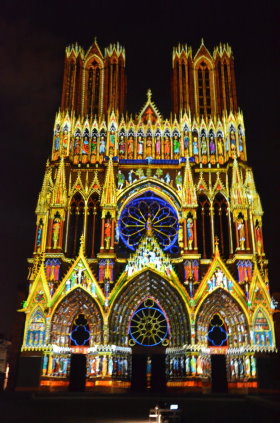
Reims Cathedral lightshow
Champagne tour from Paris is easy
Champagne is 145 kilometers east of Paris on the way to Germany. This hilly region grows the world's top sparkling wines, thanks to Don Perignon, a monk who first pioneered a number of winemaking techniques around 1670.
Champagne wines are exclusively produced from grapes grown in the Champagne region following strict rules; secondary fermentation of the wine to create carbonation, specific vineyard practices, pressing regimes unique to the region. Champagne is also a lovely region of France around the beautiful city of Reims.
A Paris to Reims tour is the easiest wine tour from Paris. There are good TGV trains from Paris to Reims and the A4 freeway connects easily the two cities.
Book a hotel or an apartment in Reims and visit the cathedral and local Champagne cellars such as Mumm cellar.

Mumm Cordon Rouge, the famous Champagne wine
Champagne wine map
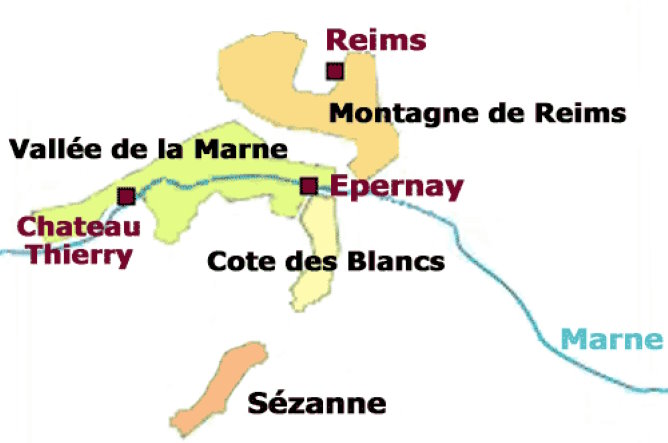
History of Champagne
Until the Middle Ages, the monks took care of the vine: the wine was consecrated and drunk during the mass. The meeting of geography and history offered Champagne wines an extraordinary destiny. It was indeed Saint Rémi, Bishop of Reims, residing near Epernay, who baptized Clovis when he converted. The first king of France was thus sacred in Champagne and the Champagne wines consecrated on Christmas Eve 496.
From 898 to 1825, it was in Reims, in the heart of the Champagne region, that the kings of France were crowned. The ceremonies, according to the stories that were made of them, were all accompanied by feasts in which the wines of Champagne flowed freely. Very quickly appreciated for their taste and finesse, these became the wines that were offered in tribute to the monarchs who came to the region.
Since the 12th century, the reputation of Champagne wines has crossed the borders and their prestige continues to grow. All the princes present at the Congress of Vienna recounted the omnipresence of Champagne from September 1814 to June 1815. From celebrations to suppers, the Congress amused itself: "the spirit sparkled like the wine of Champagne" and it was the first link unifying the participants. A symbol of excellence, Champagne has been prominently featured on the menus of royal weddings for two centuries. It was the magical and spectacular guest of the great universal exhibitions of 1889 and 1900 in Paris; and with time, it confirmed its image of exceptional wine. Today, more than ever, it is always his place that is called upon when it comes to distinguishing the rarity or grandeur of an event.
